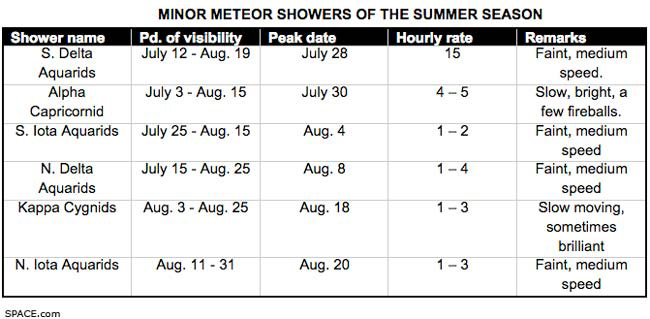Summer Meteor Shower Season in Full Swing

Forskywatchers in the NorthernHemisphere, late summer is usually regarded as the prime"meteor-viewingseason," with one of the best displays of the year reaching its peak inmid-August. But some lesser-known summer meteor displays can stilldazzle.
Thesummer meteor shower seasonhits its peak with the annual Perseidmeteorshower, which is usually beloved by everyone from meteorenthusiasts tosummer campers in August. This year will be an excellent onefor the Perseids,as their peak will nearly coincide with a new moon, which should offerdarkskies for prospective observers.
Butthe Perseids aren't the onlymeteor show in town. [Stunningmeteor shower photos.]
Meteorshower basics
Ingeneral, the Earth encountersricher meteoric activity during the second half of every year. Andskywatchersare more likely to see twice as many meteors per hour in the predawnhours ascompared to the evening hours.
Thisis due to the fact that duringthe pre-midnight hours we are on the "trailing" side of the Earth,due to our orbital motion through space. So any meteoric particlegenerallymust have an orbital velocity greater than that of the Earth to "catch"us.
However,after midnight when we areturned onto the Earth's "leading" side, any particle that lies alongthe Earth's orbital path will enter our atmosphere as a meteor. As suchobjectscollide with our atmosphere at speeds of 7 to 45 miles per second,their energyof motion rapidly dissipates in the form of heat, light, andionization,creating short-lived streaks of light popularly referred to as "shootingstars."
Breaking space news, the latest updates on rocket launches, skywatching events and more!
Summertimemeteors, occasionally flitting across your line of sight areespeciallynoticeable between mid-July and the third week of August. Andbetween Aug. 3and 15, there are no fewer than six different minor displaysthat areactive. These six are listed in the accompanying table. [Table: Summer Meteor Shower Viewing Guide]
Theonly equipment you'll need is clearweather, your eyes and a modest amount of patience.
Whatyou might see
Theactual number of meteors asingle observer can see in an hour depends strongly on skyconditions. Therates given in the table are based on a limited star magnitude of +6.5(consideredto be the faintest star visible to the naked eye without the use ofbinocularsor a telescope; a really good sky!), an experienced observer, and anassumptionthat the radiant is directly overhead.
Theradiant is the place in the skywhere the paths of shower members, if extended backward, wouldintersect whenplotted on a star chart. Your clinched fist held at arm's length isequal toroughly 10 degrees on the sky.
Soif the radiant is 30 degrees(about three fists in size) above the horizon, the hourly rate ishalved. At 15degrees it is one-third.
Whilethe hourly rates from theseother meteor streams provide but a fraction of the numbers produced bythePerseids, combined, overall they provide a wide variety of meteors ofdifferingcolors, speeds and trajectories.
Amongthese are the Southern DeltaAquarids,which can produce faint, medium-speed meteors; the Alpha Capricornids,describedas "slow, bright, long-trailed yellowish meteors" and the KappaCygnids which are classified as "slow moving and sometimes producingbrilliant flaring fireballs." As such, if you stay out and watch longenough, you may be nicely rewarded for your timespent.
Notethat five of the six showerslisted, come from the region around the constellations of Aquarius andCapricornus. These constellations are highest in the southern skybetweenroughly 1 and 3 a.m. local daylight time. The Kappa Cygnids appear toemanatefrom the constellation Cygnus, which will appear more or less overheadwithinan hour of local midnight.
Moon muscles in
Currentlythe one drawback inwatching for meteors is the moon, which will reach full phase on July25. Sinceit will be in the sky practically the entire night, the brilliant lightof July'sfull moon will likely obscure all but the very brighteststreaks.
Butin the nights that follow, themoon will be rising progressively later in the night as well as waningin phaseand brightness. After Aug. 3, the moon will have diminished to acrescent phaseand will become significantly less of a hindrance to viewers.
- Gallery? Perseid Meteor Shower, Part2
- BeginnerAstrophotography Telescopes
- July'sFull Moon Rises Sunday With 'Sea Goat'
Joe Rao serves as aninstructor and guest lecturer at NewYork's Hayden Planetarium. He writes about astronomy for The New YorkTimes andother publications, and he is also an on-camera meteorologist for News12Westchester, New York.

Joe Rao is Space.com's skywatching columnist, as well as a veteran meteorologist and eclipse chaser who also serves as an instructor and guest lecturer at New York's Hayden Planetarium. He writes about astronomy for Natural History magazine, Sky & Telescope and other publications. Joe is an 8-time Emmy-nominated meteorologist who served the Putnam Valley region of New York for over 21 years. You can find him on Twitter and YouTube tracking lunar and solar eclipses, meteor showers and more. To find out Joe's latest project, visit him on Twitter.
